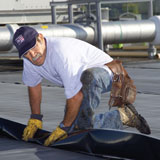"Am I going to be receiving huge increases in my insurance premiums again?" "Is the insurance industry getting any better?" These are questions roofing contractors are asking themselves this year. It's typical for the insurance industry to go through cycles, but this "hard" market has been unusually lengthy. The roofing class of business has suffered more than many other classes, so roofing contractors welcome any premium relief.
In addition, the insurance marketplace, in general, has changed for roofing contractors. Many roofing contractors in certain states, such as New York, were forced to move from admitted carriers (an insurance company authorized to do business in a state) to excess and surplus lines carriers (insurers that are not licensed to conduct business in a particular state but are permitted because coverage is not available through licensed insurers). Such insurers generally write coverage for riskier classes of business that admitted carriers don't want to cover.
Insurance agents now have become familiar with the excess and surplus lines market, and industry experts advise the excess and surplus lines market will not be going away anytime soon though there has been somewhat of a shift for commercial contractors from excess and surplus lines insurers back to admitted carriers. Agents' mentality has changed to accept the excess and surplus lines as a more common and viable market. Although admitted carriers always were the first choice and excess and surplus lines carriers were used as a one-time situation, there no longer is a significant distinction between placing a contractor with an admitted carrier vs. an excess and surplus lines carrier.
Statistics from the insurance industry and rating agencies indicate that, as a whole, insurance companies are showing improved underwriting and net income results as of 2003. 2001 seems to have been the worst year.
Industry observers also note liability premiums for contractors who conduct business on customers' properties, such as roofing contractors, currently are showing a modest decline.
However, the news isn't entirely rosy. A study published at the end of December 2004 by Standard & Poor's Ratings Service shows that though there is growth in earned premiums and a continuing decline in loss frequency leading to improved profitability, expectations are for renewed competitive pressures on insurance companies in 2005.
Although there may be a decline in loss frequency, loss severity still exists for roofing contractors. Losses caused by falls continue to plague roofing contractors, and insurers still are seeing large workers' compensation and general liability losses (more than $1 million) because of falls in varied circumstances. Some examples include the following:
- A 21-year-old roofing worker fell through a skylight that did not have proper protection. He now is a paraplegic.
- A 38-year-old roofing worker fell off the edge of a roof while on a cell phone and pulling a hot tar paper machine. The monitor tried to warn him, but he did not hear and fell 12 feet (4 m) as the hot tar from the machine poured on him, causing catastrophic burns. He never will be able to return to work.
- A 52-year-old roofing worker fell 12 feet (4 m) through a hole (with no protection) to a concrete floor below. He is on long-term disability.
Not only do you have to maintain a successful safety program to keep premiums down, you also have to contend with the general insurance marketplace cycles. What can you do to win this battle?
- With regard to fall protection:
- Continue to increase enforcement of safety programs
- Provide more attention to and emphasis on properly covering openings
- Make sure new and existing employees properly are trained and supervised
- With regard to insurance:
- Become a stronger partner with your insurance agent and loss-control representative so they can provide ideas to help train employees
- Provide your agent with complete, consistent information at renewal time to give the best picture of your company to the underwriter
- Resolve to develop new safety and risk-management skills this year
The safety of roofing workers is important to the roofing industry, as well as the insurance industry. Employing better safety training and consistent practices can help create a more stable work environment for your company and employees. Take measures to prevent accidents on rooftops so fall-protection problems do not increase your already costly insurance premiums.
Leslie Kazmierowski is NRCA's insurance programs manager.


